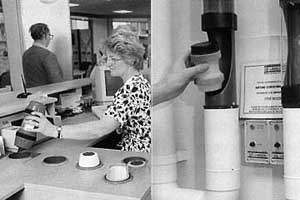Small diameter PCPs were adopted by large 'department' stores to move cash and other small items. Over time, other applications have been developed where small items need to be moved between different locations in the same building. The history of such systems is very poorly documented.
Cash Transfers in Shops and Hotels
From around 1880 there was a rise in the need to move cash around shops and hotels. This reflected a rise in the size of shops and hotels, particularly in the US and Europe. There was a greater need to move small consignments of coinage around within buildings. Initially this was achieved using humans (sometimes referred to in America as Elevator Boys), but this was regarded as an inefficient use of time. A number of systems were developed, many based around ropeway systems, with small baskets containing coins [1]. For further discussion of these systems see [5].
Pneumatic systems, almost identical to the small bore PCP systems used to transport messages, were tried by a number of shops. The early systems did not receive favourable reviews. One review ([1]) states, "The system examined did not appear to differ from the ordinary pneumatic tubes and, while it is much more rapid [than any other system suitable for use in shops] ... it did not offer any special advantages. The stations were too far apart, and the multiplicity of pipes unsightly and inconvenient."
A number of improvements were made to the pneumatic system during the 1880s. A. J. Boult [2] makes a number of important advances, including an improved mechanism by which to route capsules around complex networks. This type of development allowed many terminals to be built within shops, addressing some of the earlier failings of the system. Boult also appears to have been the first to develop the capsule design used in modern systems. His capsule took the form of a metal cylinder, with twin rubber recessed end pieces. Such a capsule would have been able to efficiently move a far heavier weight of cargo than the capsules used up to that date (which were designed primarily to convey paper). This design has remained unchanged since, except for the use of plastics and other modern materials. A number of other advances are made during the period, that start to make the design of shop and hotel based systems significantly different from those used in pneumatic despatch systems. T. R. Shillito, for example, develops a valve which allows capsules to be dropped into the system by shop staff, rather than manually pushed into, and secured within the system [3].
Other Applications

A modern pneumatic transfer system in operation, showing two types of despatching terminal (Source: Lamson).
By the start of the 20th century PCPs seems to have become the most popular form of technology for transferring cash within shops, and to a less extent, hotels and other business premises. This pattern continues in certain areas: Most major United Kingdom supermarkets and banks with open-plan branches, for example, currently use such systems from the movement of cash to more secure locations within their premises. Systems could often be found in large office buildings, to move paper messages.
There is a general perception that the use of these systems declined in the later half of the century. One explanation is that older designs of system often required intensive maintenance to keep them reliable, as so became either expensive or unreliable. Alternatively, it may be the case that systems were better integrated into the locations they served, and so people were less likely to see them.
The introduction of modern materials and control systems was important in rejuvenating small diameter PCP systems since the 1980s. Plastics, for example, increasingly allowed systems to be hidden from view, made the operation of systems quieter, and reduced maintenance requirements. Electronic control systems have been developed which allow more complex movement patterns to occur, with almost no risk of loss of the items being transported. The basic principles of the technology remains largely unchanged from that used at the start of the 20th century.
Systems are often found where small physical items need to be regularly transferred between certain fixed locations. In these locations the systems have often replaced inefficient manual carriage by an individual person. These have been used to convey: medical samples within hospital sites; industrial samples from manufacturing parts of a factory to test facilities; movement of smaller aircraft spare parts within an airport; various documents within offices; and cash [4].
Notes
- Anon, (1882), 'Shop Conveniences', The Century; a popular quarterly, Vol. 24, Issue 6, Oct.
- UK Patents 1887, no. 3914 and no. 3915, Boult AJ [McLaughlin JF], Mar 15.
- UK Patents 1889, no. 14788, Shillito TR [Wildemann J], Sept 19.
- Lamson, (1996), D. D. Lamson - Physical Transfer Systems, Customer Information, Gosport.
- Buxton, A., (Undated), The Cash Railway Website, http://www.ids.u-net.com/cash/.